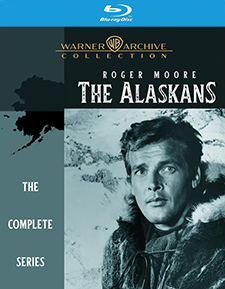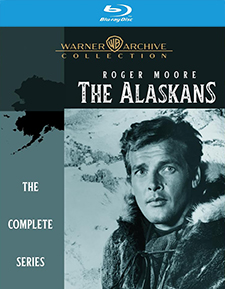Alaskans, The: The Complete Series (Blu-ray Review)

Director
VariousRelease Date(s)
1959-1960 (August 27, 2024)Studio(s)
Warner Bros. Television (Warner Archive Collection)- Film/Program Grade: C+
- Video Grade: A
- Audio Grade: A
- Extras Grade: F
Review
As far as Hollywood’s major studios were concerned, television was the mortal enemy from its dissemination in the late 1940s through the mid-1950s. They generally would not allow their contract stars to appear on the new medium, nor license their old and recent movies for broadcast. By 1955, however, there was no question that television was here to stay, but still the big studios wanted to enter the medium under their own terms. Taking its cue from Walt Disney’s Disneyland show, Warner Bros. launched Warner Bros. Presents; like Disney’s veritable weekly commercial for his new theme park, Warner Bros. hoped to game the system, to use tee-vee to plug its upcoming movies. Unlike Disney, who packed Disneyland with classic cartoons and quality original programs like Davey Crockett, Warner Bros.’ “wheel series” focused mainly on its 10-15-minute Behind the Camera segments, plugging upcoming movies; for them the rest was filler, almost an afterthought. Of the three alternating programs—Casablanca, Kings Row, and Cheyenne—only the latter was a success. (Is anyone clamoring for Blu-ray releases of the other two? No, I would imagine.) Commercial sponsors forced WB to drop the Behind the Camera segments, the program was briefly rechristened Conflict, and then canceled altogether, with only Cheyenne spinning off into its own series.
However, the studio developed strong ties with the struggling ABC Television Network, and continued churning out programs. A few of these, including Maverick and 77 Sunset Strip, both piloting on Conflict, became big hits, but overall Warner Bros. was notoriously cheap and unambitious. Upstart television companies like Revue were producing much superior programs.
In the midst of this fury of television production came The Alaskans (1959-1960), a “Nor-Western” set in Skagway during the Klondike Gold Rush of the late-1890s. Roger Moore, post-Ivanhoe but pre-The Saint, stars as “Silky” Harris, with Jeff York playing his sometime-partner, sometime-rival “Reno” McKee, and with Dorothy Provine as upwardly-mobile saloon singer “Rocky” Shaw.
The basic problem with The Alaskans is its constantly shifting tone, though mostly it’s shamelessly imitative of Maverick, with Silky and Reno much less interesting variations of Brett and Bart Maverick. Some episodes adopt a (very slightly) more serious tone, but really the show is all over the map, and rarely good. One episode, The Abominable Snowman, is even a quasi-horror show directed by Lew Landers, who helmed The Raven (1935) and The Return of the Vampire. That episode offers some interesting, offbeat atmosphere, but is saddled with a terrible script. That and virtually all other episodes overflow with narrative filler, pointless scenes whose sole purpose is to expose enough film to fill the hour format. The Alaskans might have worked better as a half-hour show like WB’s entertaining (if only occasionally ambitious) Lawman, which is still fun to watch.
Roger Moore, in his recommended autobiography My Word Is My Bond, has few kind things to say about his stint on The Alaskans. The grueling shooting schedule combined with a cast forced to wear heavy furs and the like in the stifling Southern California heat, combined with problems like carpenter’s nail getting mixed into the artificial snow, made it a miserable experience for all concerned.
Worse, the indentured servant-like conditions at Warner Bros. prompted both Cheyenne’s Clint Walker and Maverick’s James Garner to rebel just as a 1960 Writers Guild of America labor strike threatened all Warner-produced series. Rather than shut down production on The Alaskans, scripts written for Maverick or Bronco were remade with few changes as new Alaskans shows, fooling almost no one. (These notorious shows were credited to “W. Hermanos,” Spanish for “W. Brothers.”) When The Alaskans met its ignominious end, Moore was shifted into the departing James Garner’s spot on Maverick, while Dorothy Provine moved on to another WB series, The Roaring 20s, playing virtually the same part under a different name.
To be clear, the program has some entertainment value: Moore is fun to watch, as is York, fresh from his stint as Mike Fink in Disney’s Davy Crockett shows. The studio’s attempt to recreate 1890s Alaska are sometimes imaginative and almost believable but also amusingly phony at times; sometimes shadows of the actors appear on painted “sky” backdrops. And it’s fun to see the many guest stars: Julie Adams, Claude Akins, Robert Colbert (yet another future Maverick), Leo Gordon, Alan Hale, Jr., John Hoyt, Ruta Lee, Simon Oakland, Rex Reason, Madlyn Rhue, Dick Sargent, Lee Van Cleef, Marie Windsor, etc.
Plus, the show looks great. For The Alaskans: The Complete Series, Warner Archive scanned in 4K the original camera negatives, so the black-and-white, 1.33:1 series has never looked better. Included are original commercial bumpers and ABC network logos. The DTS-HD Master Audio 2.0 mono is excellent, and optional English subtitles are provided. The generous bitrate is apparent in that just four episodes appear on each of its nine discs, which are Region-Free. No extra features, however.
Not as good as Maverick at its best, nor better WB Westerns like Lawman, The Alaskans is nonetheless moderately entertaining, just not very good. Fans of classic television, especially classic TV Westerns, will likely find it worthwhile anyway, especially given the excellent video transfers—one just wishes the show were better than it is.
- Stuart Galbraith IV

